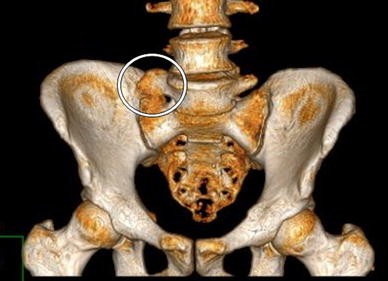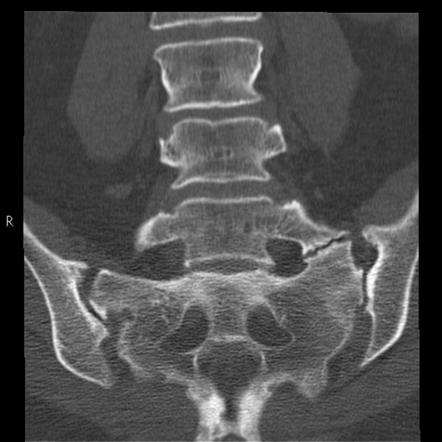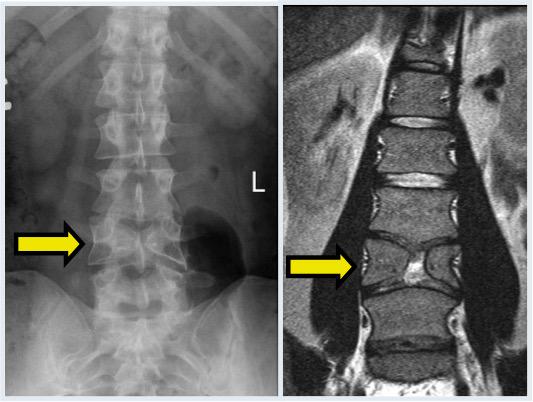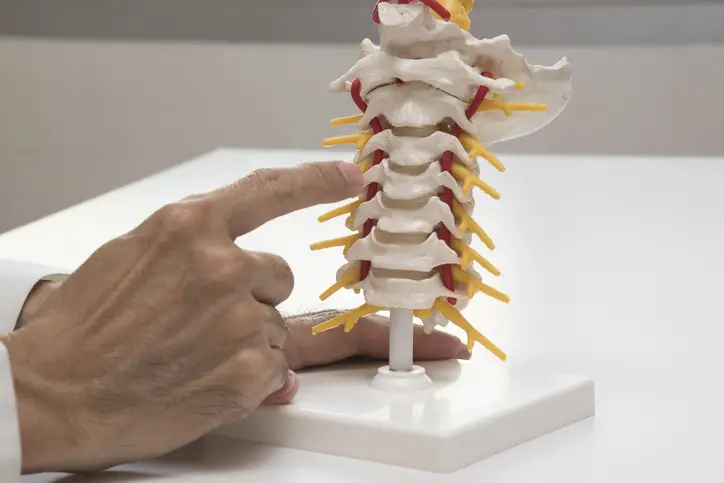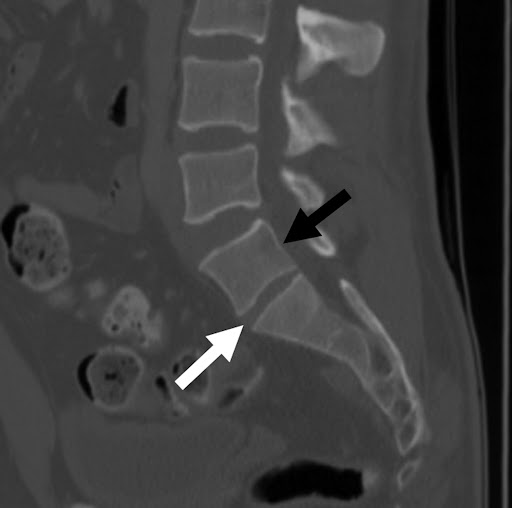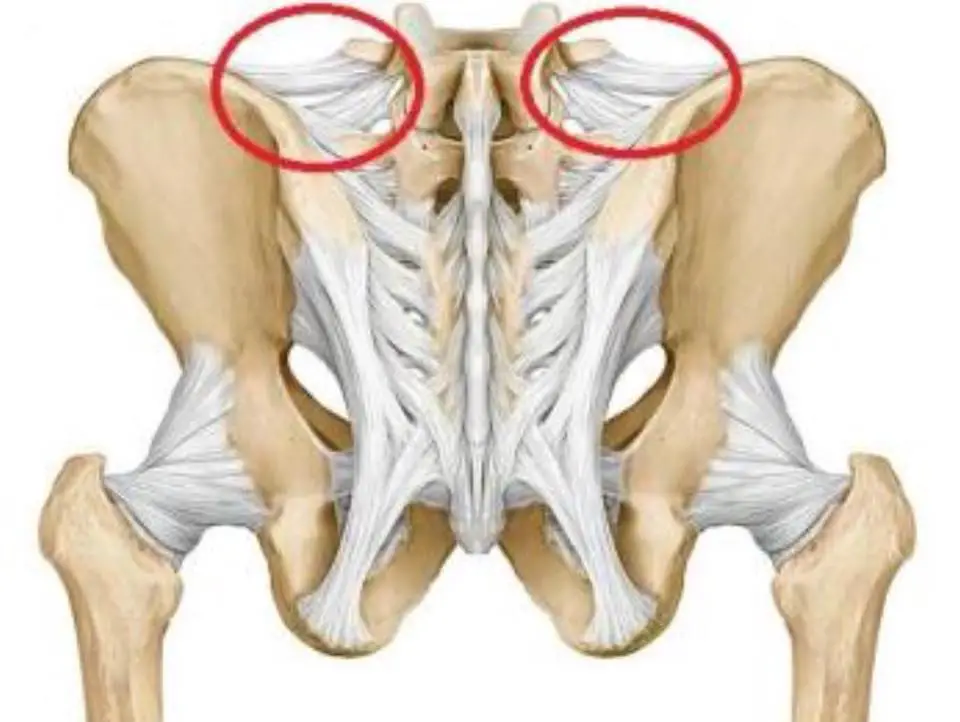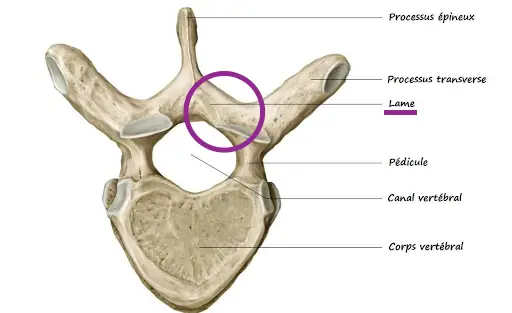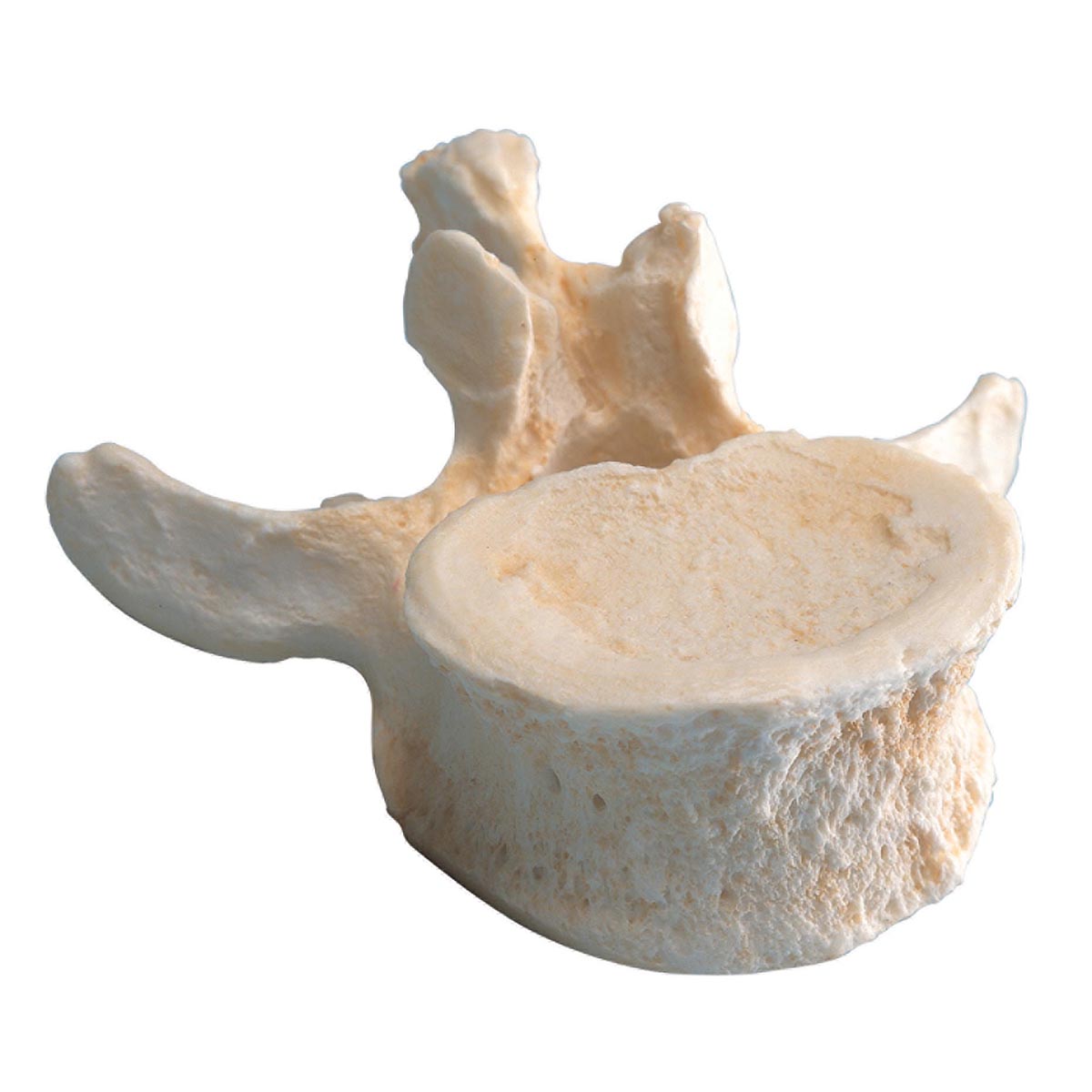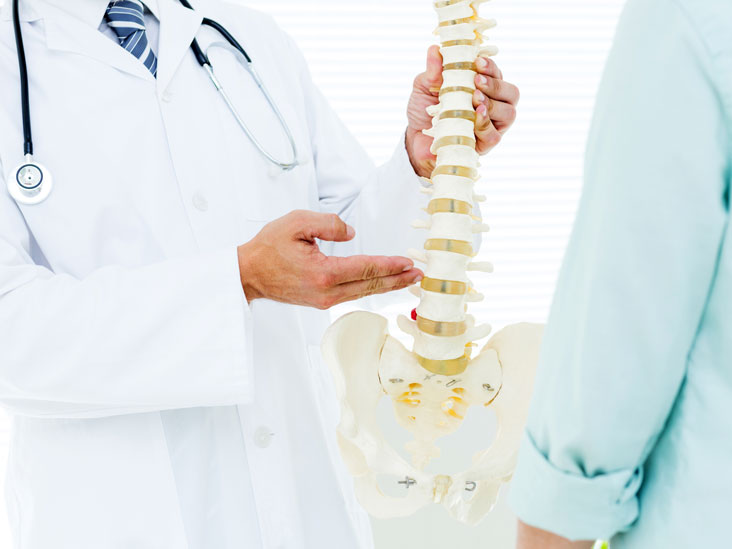Article reviewed and approved by Dr. Ibtissama Boukas, physician specializing in family medicine
L5 lumbar sacralization is a condition of the spine where the fifth vertebrate (L5) is fused to the sacrum bone. It is a congenital anomaly that occurs in the embryo, and which can affect only one side or both in a total or partial way.
What is lumbar sacralization, and should we worry if the doctor gives us this diagnosis? Is it related to back pain? What are the treatments to reduce the pain when it is present?
This popular article explains everything you need to know about this spinal condition.
Definition and anatomy
In the vertebral column, there are 5 vertebrae lumbar located in the lower back. Just below, there are 5 sacral vertebrae of triangular shape and welded, and which ends in the coccyx.
The vertebral column forms during embryonic development. In some cases, changes can cause congenital malformations, resulting in an abnormality in the vertebrae, for example.
Lumbar sacralization
Lumbar sacralization is a type of birth defect in which the last lumbar vertebra (L5) is completely or partially fused with the sacrum (or the iliac bone in some cases). This fusion can occur on one side only (hemi sacralization) or on both sides.
Due to lumbar sacralization, the L5 vertebra appears more like a sacral vertebra. This is where the term comes from “L5 sacralization”.
The exact cause of sacralization is not yet known. We know that it occurs during embryonic development, when the vertebrae begin to ossify, around the eighth week. It is believed that a genetic predisposition could cause this spinal condition.
It is a more common condition than one might imagine, with an estimated incidence of 4-36% Population. In people under the age of 30, it is estimated that 18,5% are affected by lumbar sacralization.
Sacralization should not be confused with lumbarization, another birth defect of the spine. Less common, the lumbarization is a condition where the first sacral vertebra (S1) is separated from the other sacral vertebrae instead of being fused to it. It is then said that it is part of the lumbar spine, and can also cause lower back pain.
Diagnostic
The diagnosis is made by medical imaging. Generally, an X-ray or CT scan is sufficient to determine the presence of the sacralization, as well as its characteristics (bilateral, unilateral or hemi-sacralization, fused with the iliac bone, etc.).
We use the Castellvi's classification to better describe lumbar sacralization.
The Castellvi classification is as follows:
- Type 1: a fusion of at least 19 mm in width on one side (hemi sacralization), or on both sides.
- Type 2: incomplete fusion with formation of a pseudojunction on one or both sides.
- Type 3: complete fusion of L5 and sacrum on one side or the other
- Type 4: combination of type 2 and type 3.
Symptoms: Consequences of sacralization
The sacralization of the last lumbar vertebra is not necessarily synonymous with back pain. Indeed, it can be asymptomatic in several cases, mainly due to the adaptability of the human body. Even today (and despite scientific studies), the relationship between sacralization and low back pain is unclear.
On the other hand, it is possible that lumbar sacralization causes symptoms in some people. A survey on low back pain found that the number of people with low back pain AND who also had sacralization ranged from 6 to 37%. Furthermore, another survey suggested that the presence of L5 sacralization may aggravate pain in those who already suffer from back pain.
Symptoms will vary depending on the severity of the malformation, and each individual. In the presence of lumbar pain associated with sacralization, we speak of “ Bertolotti syndrome"
From a biomechanical point of view, it must be understood that an L5 vertebra fused with the sacrum modifies the functioning of the lumbar region and the sacrum. In particular, it affects trunk mobility, posture, the biomechanics of the upper and lower vertebrae, etc.
For example, sacralization can affect the center of gravity at the base of the spine. As the fifth lumbar vertebra is fused with the sacrum, the fourth lumbar vertebra (L4) therefore becomes the "last" lumbar vertebra.
Since the L4 vertebra is not anatomically suited to perform the same support functions as the L5 vertebrae, this causes compensations and overuse of this region.
In short, lumbar sacralization can remain asymptomatic if the body succeeds in adapting from an anatomical and biomechanical point of view. On the other hand, this condition can also affect back movements and posture, especially if the sacralization is unilateral. The overlying and underlying vertebrae will have to work more, which can cause dysfunctions.
More specifically, here is what can be observed in some people with lumbar sacralization:
- Lower back pain and muscle spasms (due to compensation of related structures)
- Scoliosis (due to altered biomechanics due to fusion)
- Postural disorders
- Limited range of motion in the lumbar region
- Herniated disc (due to L5-S1 disk compression)
- disc protrusion and other disc disease overlying vertebrae (such as L4-L5)
- Lumbar osteoarthritis
- Zygapophyseal osteoarthritis
- Sciatica
- Cruralgia
Treatment
If the condition remains asymptomatic, no treatment will be put forward. On the other hand, if sacralization causes pain, here are some frequently used treatment modalities:
- Painkiller and anti-inflammatory medication
- Muscle relaxants in the presence of muscle spasms
- Natural products for pain management
- Massages and mobilizations from the physiotherapist (physiotherapist) or osteopath
- Infiltration to reduce inflammation as needed
- Medicine and alternative therapies (acupuncture, cupping etc.)
- Surgery as a last resort (to treat the consequences of sacralization)
In addition to the treatments mentioned above, there are several products and accessories available on the market to relieve lower back pain related to lumbar sacralization. It should be remembered that these tools generally provide temporary relief, and should be used sparingly.
Among the products recommended by our professionals, we have:
- acupressure mat : it relaxes the muscles and provides a feeling of well-being.
- Heated lumbar belt : It combines a lumbar support effect and a feeling of comfortable warmth aimed at relaxing tense muscles.
- Postural T-Shirts : It offers a feeling of support and helps to maintain a straight posture.
- Ergonomic back cushion : It offers support in a seated position, and improves tolerance in this position.
- massage gun : It reduces muscle tension by providing specific and adapted massages.
- Spinal decompression table : Used in the advanced phase (especially not in the acute phase!), it allows the lumbar vertebrae to be decoupled for relief at this level.
- Dorsal stretcher : This device accentuates lumbar lordosis, allowing the spine to be mobilized in extension and stretching the abdominals for temporary relief.
Although L5 sacralization cannot be corrected from an anatomical point of view, it is possible to act on the functional consequences related to this condition. For example, core mobility and strengthening exercises will reduce the overload on the related vertebrae. Specific stretches will reduce stress on the lumbosacral region.
The diagnosis of lumbar sacralization is therefore not inevitable, and it is possible to continue one's professional, sporting or leisure activities following appropriate treatment. A qualified health professional will be able to guide you if you ever suffer from this condition.
What about natural remedies?
Although they are not supported by solid scientific evidence, several natural products and home remedies are used to treat various body pains, especially for their anti-inflammatory power.
Here is a non-exhaustive list of plants and essential oils that are effective in controlling pain and inflammation:
- Turmeric : Thanks to its antioxidant and anti-inflammatory powers very powerful, turmeric is one of the most used plants in a culinary and therapeutic context. The composition of turmeric is essentially made of essential oils, vitamins (B1, B2, B6, C, E, K) and trace elements. But it is to its composition rich in curcumin and curcuminoids that we owe them and calm skin of this spice.
- REASON TO CHOOSE OUR TURMERIC CAPSULES WITH GINGER AND BLACK PEPPER – Our complex turmeric…
- POWERFUL TURMERIC CAPSULES - Turmeric is an excellent source of Vitamin C, antioxidants,…
- IDEAL AND PRACTICAL FORMULA – The powders we use are delicately harvested,…
Last updated on 2024-04-16 / Affiliate links / Images from the Amazon Partners API
- Ginger : In addition to the special flavor it brings to the kitchen and its aphrodisiac properties, ginger is a root well known for its anti-inflammatory powers. THE gingerol gives it its anti-inflammatory action. It is an active component acting on the inflammatory pain related to chronic joint inflammatory diseases, including rheumatoid arthritis, lupus, rheumatic diseases, etc. It has been proven that this active element is also effective in acting on the inflammation linked to arthritis and sciatica. Ginger also has other benefits thanks to its high potassium content and its richness in trace elements (calcium, magnesium, phosphorus, sodium) and vitamins (provitamin and vitamin B9).
- 【Natural Ginger Foot Patches】: Natural Foot Detox Patch with Ginger and…
- 【Ginger Anti Swelling Detox Patch】: Ginger Detox Patches are natural,…
- 【Removes Body Toxins】: Ginger Foot Patches helps reduce the buildup of…
Last updated on 2024-04-16 / Affiliate links / Images from the Amazon Partners API
- Omega-3s : Omega-3 are polyunsaturated fatty acids that play a very important role in the functioning of our body. They are provided by food in three natural forms: docosahexaenoic acid (DHA), alpha linolenic acid (ALA) and eicosapentaenoic acid (EPA). Beyond their action on the brain and the cardiovascular system, omega-3s prove very effective against inflammation. Indeed, they have the ability to act on the inflammatory mechanisms in osteoarthritis by slowing down cartilage destruction, thus they reduce the intensity of osteoarthritis pain. Sciatica, being most often linked to an inflammation secondary to a herniated disc, it can also respond to omega-3 provided it is consumed regularly.
No product found.
- Lemon eucalyptus: Eucalyptus is a plant most often used in the form of herbal tea or essential oil. She would have anti-inflammatory effects which give it the ability to act on the bone and joint pain in general and the pain of sciatica in particular.
- Eucalyptus Citriodora Essential Oil.
- 100% pure.
- Botanical name: eucalyptus citriodo.
Last updated on 2024-04-16 / Affiliate links / Images from the Amazon Partners API
- wintergreen : Wintergreen is a shrub from which a very interesting essential oil is extracted. It is one of the most used essential oils in aromatherapy. This oil extracted from the shrub bearing the same name, is used in massage to relieve sciatica and act like a analgesic. Indeed, it provides a heating effect thanks to its ability toactivate blood circulation locally.
- PROPERTIES ORGANIC WINTERGOOD ESSENTIAL OIL: Wintergreen essential oil is…
- DIRECTIONS FOR USE: Refer to the instructions or ask your pharmacist for advice, This…
- PURESSENTIEL DNA: A range of 55 essential oils essential for well-being in the…
Last updated on 2024-04-16 / Affiliate links / Images from the Amazon Partners API

